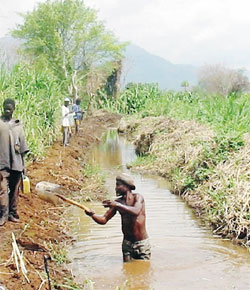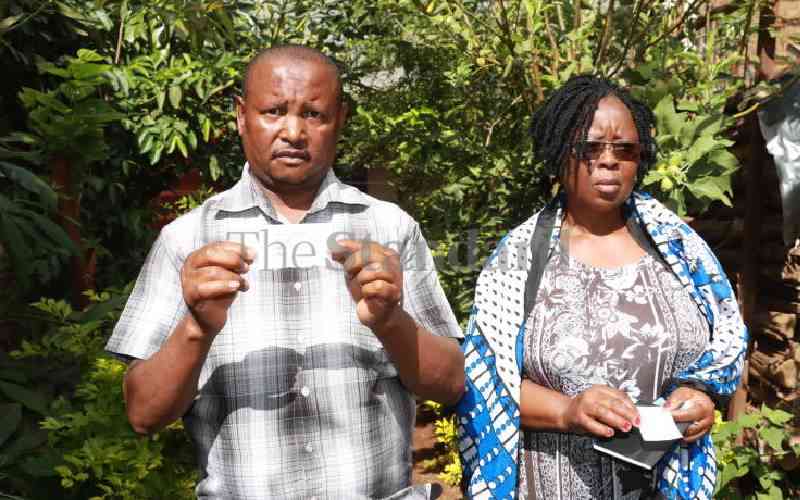By Philip Mwakio
In 2001, Lake Jipe in Taveta District was nearly drying up, before efforts to revive it began in earnest.
The lake, shared between Kenya and Tanzania, had lost about 50 per cent of its water and became a muddy slosh.
This was largely due to destruction of water catchment areas, proliferation of the typha weed and diversion of fresh water recharge from River Lumi.
The Lumi, in Taveta District, is Jipe’s major inlet while River Ruvu, in Tanzania, serves as its outlet.
 |
Mzee Mwachofi and fellow residents in Mata location, Taveta District work on river banks along their farms. |
Today, there is hope the lake could be fully revived, thanks to efforts of locals and the East African Wildlife Society (EAWLS).
The UNDP Global Environmental Facility gave grants to registered community groups to help salvage the lake.
Sowene says about Sh24 million has been used for various activities to restore the lake.
Bearing fruit
EAWLS deputy director Hadley Benny says efforts to restore the scenic water body are slowly bearing fruit.
"The lake is an important watering point for wildlife, livestock and human beings, especially during dry spells," he says.
Becha says the lake is second to Lake Naivasha in wetland biodiversity in Kenya and is the only place where endemic fish species of Orechromis Jipe and Oreochromis Grigan are found.
Former councillor Lorogwa Kolokolo Sowene, and now chairman of the Taveta District Environmental Association, says their efforts and funding from donors have helped a great deal.
"EAWLS has been instrumental in conservation efforts here and we could not have done it alone," he tells The Standard.
Stay informed. Subscribe to our newsletter
"EAWLS introduced initiatives to address environmental problems of Jipe and the River Lumi basin in 2003," he says.
EAWLS-Taveta field officer Moses Ziro says a cluster of seven projects forms the Lake Jipe Restoration Initiative.
"The projects check and reverse the degradation of the lake and the Lumi ecosystem. They also improve the livelihoods of the community through fish farming, bee keeping and a return to normal farming after de-flooding of farms," he says.
Ziro says Lake Jipe basin is now 75 per cent back to its original form with fish now in abundance and in large sizes.
Priority
Priority areas included desilting of canals such as Muguru, Sombasomba, Maloja, Kamleza and block C area of the lake.
There was also the River Lumi bank stabilisation in Jipe and Kimorigho locations.
Water catchment areas and springs such as Njoro Kubwa and Njoro Mata springs were also secured.
Organised community groups were involved in building water pans to reduce human-wildlife conflict and increase availability of water for domestic use.
There was also creation of sustainable enterprises like bee keeping, fish farming and agro-forestry.
Mr Edwin Kimaru Swai, co-ordinator of Reu Reu Environmental Group, terms the restoration a miracle.
Njoro Kubwa springs is the main source of water for both River Lumi and Lake Jipe.
His group has completed half the height of a 270 a dyke to protect the springs from siltation by floods from River Lumi.
Group chairperson Mary Ngaluma says they are also involved in agro-forestry.
A tree nursery has been set up within Njoro Kubwa catchment area to supply tree seedlings.
The group also got of 15 beehives, a nine-frame centrifugal machine and other modern bee keeping equipment from German aid agency, the GTZ.
The project can produce two tonnes of honey annually, worth Sh360,000.
Mr Peter Jumanne, an official of Kimorigho River Lumi Rehabilitation Works group, says they have stabilised 14km of the river. "This has helped contain river water and prevent it from flooding nearby farms," he says.
He, however, concedes that a hippo menace has proved a big draw back.
"Since hippos stray upstream and destroy the raised river banks, a way to contain them must be found," he says.
Mata assistant chief Basil Mwagodi says they have completed construction of two dams and another within the expansive Tsavo West National Park is ongoing.
Training
"We were trained on water pan construction technology at the Egerton University," he says.
The check dams are yet to be filled with water to provide alternative watering points for wildlife and livestock.
They will be completed by January.
Tugurane Women Group chairperson Halima Rajab Mruttu, says they partnered with EAWLS to educate the community on environmental conservation.
"We have carried out several environmental campaigns in the district and are glad the lake is returning to its former beautiful nature," she says proudly.
 The Standard Group Plc is a
multi-media organization with investments in media platforms spanning newspaper
print operations, television, radio broadcasting, digital and online services. The
Standard Group is recognized as a leading multi-media house in Kenya with a key
influence in matters of national and international interest.
The Standard Group Plc is a
multi-media organization with investments in media platforms spanning newspaper
print operations, television, radio broadcasting, digital and online services. The
Standard Group is recognized as a leading multi-media house in Kenya with a key
influence in matters of national and international interest.
 The Standard Group Plc is a
multi-media organization with investments in media platforms spanning newspaper
print operations, television, radio broadcasting, digital and online services. The
Standard Group is recognized as a leading multi-media house in Kenya with a key
influence in matters of national and international interest.
The Standard Group Plc is a
multi-media organization with investments in media platforms spanning newspaper
print operations, television, radio broadcasting, digital and online services. The
Standard Group is recognized as a leading multi-media house in Kenya with a key
influence in matters of national and international interest.








